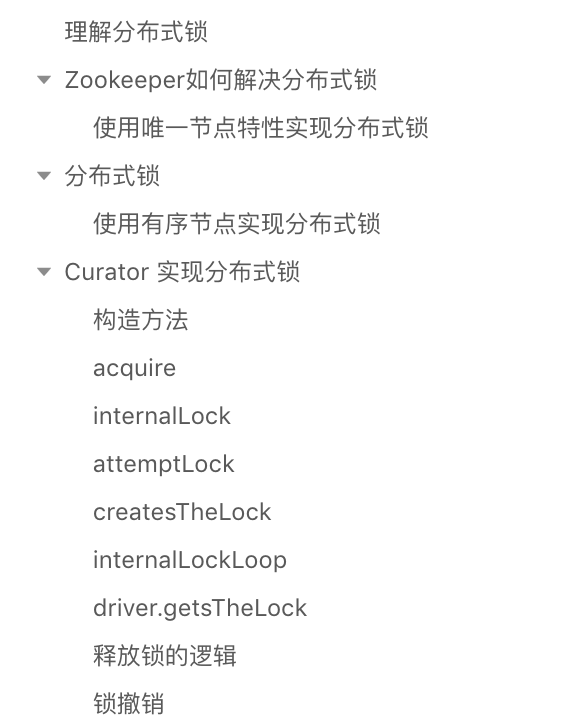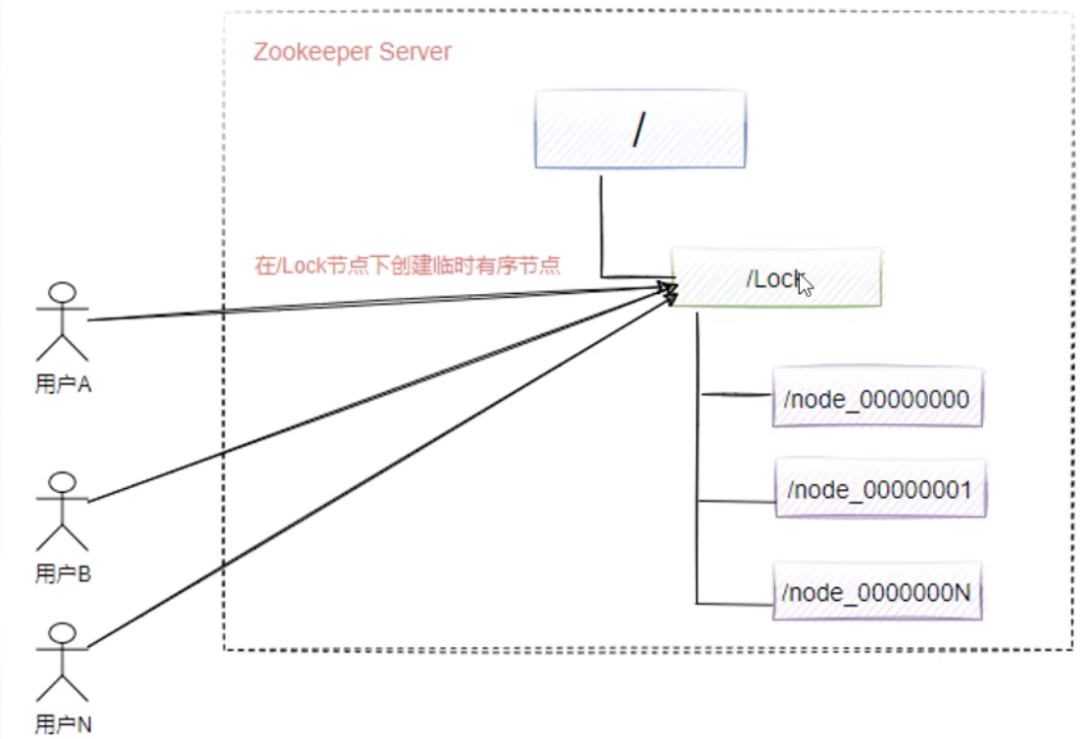基于Zookeeper实现分布式锁,如何解决羊群问题?
基于Zookeeper实现分布式锁,如何解决羊群问题?

目录:

理解分布式锁
我们先来看一个问题,如图所示,两个用户同时去抢购秒杀商品,当秒杀服务同时收到秒杀请求 时,都去进行库存扣减,此时在没有做任何处理的情况下,就会导致库存数量变成负数从而导致超卖现 象。
这种情况下我们一般会选择加锁的方式来避免并发的问题。但是在分布式场景中,采用传统的锁并不能
解决跨进程并发的问题,所以需要引入一个分布式锁,来解决多个节点之间的访问控制。

Zookeeper如何解决分布式锁
我们可以基于Zookeeper的两种特性来实现分布式锁,先来说第一种。
使用唯一节点特性实现分布式锁
分布式锁:创建节点
就是基于唯一节点特性,如图所示。多个应用程序去抢占锁资源时,只需要在指定节点上创建一 个 /Lock 节点,由于Zookeeper中节点的唯一性特性,使得只会有一个用户成功创建 /Lock 节点,剩 下没有创建成功的用户表示竞争锁失败。

这种方法能达到目的,但是会有一个问题,如图所示,假设有非常多的节点需要等待获得锁,那么等待的方式自然是使用 Watcher 机制来监听 /lock 节点的删除事件, 一旦发现该节点被删除说明之前获得锁的节点已经释放了锁,此时剩下的 B、C、D。。节点同时会收到删除事件从而去竞争锁,这个过程会产生惊群效应。
问题:
- 大量线程竞争锁,获取不到锁时,需要监听该节点的删除事件
- 删除后,会触发惊群效应
- 多个并发线程监听,对于 Zookeeper 也是种负担,对于分布式协调一致性的中间件,性能的考量也是十分重要的。

但是会产生“惊群效应”,简单来说就是如果存在许多的客户端在等待获取锁,当成功获取到锁的进程释放该节点后,所有处于等待状态的客户端都会被唤醒,这个时候 zookeeper 在短时间内发送大量子节点变更事件给所有待获取锁的客户端,然后实际情况是只会有一个客户端获得锁。如果在集群规模比较大 的情况下,会对 zookeeper 服务器的性能产生比较的影响。
分布式锁
使用有序节点实现分布式锁
因此为了解决这个问题,我们可以采用 Zookeeper 的有序节点特性来实现分布式锁。
如图所示,每个客户端都往指定的节点下注册一个临时有序节点,越早创建的节点,节点的顺序编号就越小,那么我们可以判断子节点中最小的节点设置为获得锁。如果自己的节点不是所有子节点中最小的,意味着还没有获得锁。这个的实现和前面单节点实现的差异性在于,每个节点只需要监听比自己小的节点,当比自己小的节点删除以后,客户端会收到 watcher 事件,此时再次判断自己的节点是不是 所有子节点中最小的,如果是则获得锁,否则就不断重复这个过程,这样就不会导致羊群效应,因为每个客户端只需要监控一个节点。
使用临时有序节点

如图所示,表示有序节点实现分布式锁的流程。

Curator 实现分布式锁源码解读
在本节中我们使用Curator来实现分布式锁。为了实现分布式锁,我们先演示一个存在并发异常的场
景。
<dependency>
<groupId>org.apache.curator</groupId>
<artifactId>curator-framework</artifactId>
<version>5.2.0</version>
</dependency>
<dependency>
<groupId>org.apache.curator</groupId>
<artifactId>curator-recipes</artifactId>
<version>5.2.0</version>
</dependency>Spring Boot 工程模拟订单多线程并发减库存操作,通过 Jmeter 模拟。
如果上述代码使用jmeter进行压测,用1500个线程,库存数量设置成100,监视数据库中库存的变化发现, 整个库存变化过程是非常混乱的。
@Configuration
public class CuratorConfig {
@Bean
public CuratorFramework curatorFramework(){
CuratorFramework curatorFramework=CuratorFrameworkFactory
.builder()
.connectString("loclahost:2181")
.sessionTimeoutMs(15000)
.connectionTimeoutMs(20000)
.retryPolicy(new ExponentialBackoffRetry(1000,10))
.build();
curatorFramework.start();
return curatorFramework;
}
}
@Scope(scopeName = "prototype")
@RestController
@RequestMapping("/goods-stock")
public class GoodsStockController {
@Autowired
IGoodsStockService goodsStockService;
@Autowired
CuratorFramework curatorFramework;
@GetMapping("{goodsNo}")
public String purchase(@PathVariable("goodsNo")Integer goodsNo) throws Exception {
QueryWrapper<GoodsStock> queryWrapper=new QueryWrapper<>();
queryWrapper.eq("goods_no",goodsNo);
//基于临时有序节点来实现的分布式锁.
InterProcessMutex lock=new InterProcessMutex(curatorFramework,"/Locks");
try {
lock.acquire(); //抢占分布式锁资源(阻塞的)
GoodsStock goodsStock = goodsStockService.getOne(queryWrapper);
Thread.sleep(new Random().nextInt(1000));
if (goodsStock == null) {
return "指定商品不存在";
}
if (goodsStock.getStock().intValue() < 1) {
return "库存不够";
}
goodsStock.setStock(goodsStock.getStock() - 1);
boolean res = goodsStockService.updateById(goodsStock);
if (res) {
return "抢购书籍:" + goodsNo + "成功";
}
}finally {
lock.release(); //释放锁
}
return "抢购失败";
}
}构造方法
InterProcessMutex(CuratorFramework client, String path, String lockName, int maxLeases, LockInternalsDriver driver)
{
basePath = PathUtils.validatePath(path); // Locks 目录
internals = new LockInternals(client, driver, path, lockName, maxLeases);
}acquire
@Override
public void acquire() throws Exception
{
if ( !internalLock(-1, null) )
{
throw new IOException("Lost connection while trying to acquire lock: " + basePath);
}
}internalLock
private boolean internalLock(long time, TimeUnit unit) throws Exception
{
/*
Note on concurrency: a given lockData instance
can be only acted on by a single thread so locking isn't necessary
*/
Thread currentThread = Thread.currentThread();
// 判断当前线程是否获得过锁 (重入特性设计,避免死锁)
LockData lockData = threadData.get(currentThread);
if ( lockData != null ) // 说明当前线程获取到了锁
{
// 同一线程再次acquire,首先判断当前的映射表内(threadData)是否有该线程的锁信息,如 果有则原子+1,然后返回
// re-entering
lockData.lockCount.incrementAndGet();
return true;
}
// 1. Zookeeper server 创建临时有序节点
// 2. 判断创建的节点的序号是否是所有节点中最小的,如果是,则获得锁成功并返回
// 3. 否则,等待
// 映射表内没有对应的锁信息,尝试通过LockInternals获取锁
String lockPath = internals.attemptLock(time, unit, getLockNodeBytes());
if ( lockPath != null )
{
// 成功获取锁,记录信息到映射表
// 构建一个锁数据
LockData newLockData = new LockData(currentThread, lockPath);
// 存到当前线程级缓存中
threadData.put(currentThread, newLockData);
return true;
}
return false;
}// 并发安全的全局 MAP
// 映射表
// 记录线程与锁信息的映射关系
private final ConcurrentMap<Thread, LockData> threadData = Maps.newConcurrentMap();
// 锁信息
// Zookeeper中一个临时顺序节点对应一个“锁”,但让锁生效激活需要排队(公平锁),下面会继续分析
private static class LockData{
final Thread owningThread;
final String lockPath;
final AtomicInteger lockCount = new AtomicInteger(1); // 分布式锁重入次数
private LockData(Thread owningThread, String lockPath){
this.owningThread = owningThread;
this.lockPath = lockPath;
} }attemptLock
尝试获得锁,实际上是向zookeeper注册一个临时有序节点,并且判断当前创建的节点的顺序是否是最小节点。如果是则表示获得锁成功
// 尝试获取锁,并返回锁对应的Zookeeper临时顺序节点的路径
String attemptLock(long time, TimeUnit unit, byte[] lockNodeBytes) throws Exception
{
final long startMillis = System.currentTimeMillis();
// 无限等待时,millisToWait为null
final Long millisToWait = (unit != null) ? unit.toMillis(time) : null;
// 创建ZNode节点时的数据内容,无关紧要,这里为null
final byte[] localLockNodeBytes = (revocable.get() != null) ? new byte[0] : lockNodeBytes;
int retryCount = 0;// 当前已经重试次数,与CuratorFramework的重试策略有关
// 在Zookeeper中创建的临时顺序节点的路径,相当于一把待激活的分布式锁
// 激活条件:同级目录子节点,名称排序最小(排队,公平锁),后续继续分析
String ourPath = null;
boolean hasTheLock = false;
// 是否已经完成尝试获取分布式锁的操作
boolean isDone = false;
while ( !isDone )
{
isDone = true;
try
{
// 从InterProcessMutex的构造函数可知实际driver为 StandardLockInternalsDriver的实例
// 在Zookeeper中创建临时顺序节点
ourPath = driver.createsTheLock(client, path, localLockNodeBytes);
// 循环等待来激活分布式锁,实现锁的公平性,后续继续分析
hasTheLock = internalLockLoop(startMillis, millisToWait, ourPath);
}
catch ( KeeperException.NoNodeException e )
{
// 容错处理,不影响主逻辑的理解,可跳过
// 因为会话过期等原因,StandardLockInternalsDriver因为无法找到创建的临时顺序 节点而抛出NoNodeException异常
// gets thrown by StandardLockInternalsDriver when it can't find the lock node
// this can happen when the session expires, etc. So, if the retry allows, just try it all again
if ( client.getZookeeperClient().getRetryPolicy().allowRetry(retryCount++, System.currentTimeMillis() - startMillis, RetryLoop.getDefaultRetrySleeper()) )
{
isDone = false;
}
else
{
// 不满足重试策略则继续抛出NoNodeException
throw e;
}
}
}
// 成功获得分布式锁,返回临时顺序节点的路径,上层将其封装成锁信息记录在映射表,方便锁重入
if ( hasTheLock )
{
return ourPath;
}
return null;
}createsTheLock
在 Zookeeper 中创建临时顺序节点,并返回节点名称
@Override
public String createsTheLock(CuratorFramework client, String path, byte[] lockNodeBytes) throws Exception
{
String ourPath;
// lockNodeBytes不为null则作为数据节点内容,否则采用默认内容(IP地址)
if ( lockNodeBytes != null )
{
// creatingParentContainersIfNeeded:用于创建容器节点
// withProtection:临时子节点会添加GUID前缀
ourPath = client.create()
.creatingParentContainersIfNeeded()
.withProtection()
.withMode(CreateMode.EPHEMERAL_SEQUENTIAL)
.forPath(path, lockNodeBytes);
}
else
{
// CreateMode.EPHEMERAL_SEQUENTIAL:临时顺序节点,Zookeeper能保证在节点产生的顺序性
// 依据顺序来激活分布式锁,从而也实现了分布式锁的公平性,后续继续分析
ourPath = client.create()
.creatingParentContainersIfNeeded()
.withProtection()
.withMode(CreateMode.EPHEMERAL_SEQUENTIAL).forPath(path);
}
return ourPath;
}internalLockLoop
// 循环等待来激活分布式锁,实现锁的公平性
private boolean internalLockLoop(long startMillis, Long millisToWait, String ourPath) throws Exception
{
boolean haveTheLock = false;// 是否已经持有分布式锁
boolean doDelete = false;// 是否需要删除子节点
try
{
if ( revocable.get() != null ) // 锁撤销,避免死锁
{
client.getData().usingWatcher(revocableWatcher).forPath(ourPath);
}
//在没有获得锁,并且链接是启动状态的情况下持续循环
while ( (client.getState() == CuratorFrameworkState.STARTED) && !haveTheLock )
{
List<String> children = getSortedChildren();// 获取排序后的子节点列表
// 获取前面自己创建的临时顺序子节点的名称(序列号)
String sequenceNodeName = ourPath.substring(basePath.length() + 1); // +1 to include the slash
// 实现锁的公平性的核心逻辑,看下面的分析
PredicateResults predicateResults = driver.getsTheLock(client, children, sequenceNodeName, maxLeases);
// 获得了锁((比较序列号是否是最小的)),中断循环,继续返回上
if ( predicateResults.getsTheLock() )
{
haveTheLock = true;
}
else
{
// 没有获得到锁,监听上一临时顺序节点
String previousSequencePath = basePath + "/" + predicateResults.getPathToWatch();
synchronized(this)
{
try
{
// exists()会导致导致资源泄漏,因此exists()可以监听不存在的ZNode,因此采用getData()
// 上一临时顺序节点如果被删除,会唤醒当前线程继续竞争锁,正常情况下能直接获得锁,因为锁是公平的
// use getData() instead of exists() to avoid leaving unneeded watchers which is a type of resource leak
client.getData().usingWatcher(watcher).forPath(previousSequencePath);
//是否有超时机制
if ( millisToWait != null )
{
millisToWait -= (System.currentTimeMillis() - startMillis);
startMillis = System.currentTimeMillis();
if ( millisToWait <= 0 )
{
// 获取锁超时,标记删除之前创建的临时顺序节点
doDelete = true; // timed out - delete our node
break;
}
wait(millisToWait);//限时等待被唤醒
}
else
{
wait();//不限时等待
}
}
catch ( KeeperException.NoNodeException e )
{
// it has been deleted (i.e. lock released). Try to acquire again
// 容错处理,逻辑稍微有点绕,可跳过,不影响主逻辑的理解
// client.getData()可能调用时抛出NoNodeException,原因可能是锁被释放或会话过期(连接丢失)等
// 这里并没有做任何处理,因为外层是while循环,再次执行 driver.getsTheLock时会调用validateOurIndex
// 此时会抛出NoNodeException,从而进入下面的catch和finally逻辑,重 新抛出上层尝试重试获取锁并删除临时顺序节
}
}
}
}
}
catch ( Exception e )
{
ThreadUtils.checkInterrupted(e);
doDelete = true;// 标记删除,在finally删除之前创建的临时顺序节点(后台不断尝试)
throw e;// 重新抛出,尝试重新获取锁
}
finally
{
if ( doDelete )
{
deleteOurPath(ourPath);//删除当前节点
}
}
return haveTheLock;
}driver.getsTheLock
StandardLockInternalsDriver
@Override
public PredicateResults getsTheLock(CuratorFramework client, List<String> children, String sequenceNodeName, int maxLeases) throws Exception
{
// 之前创建的临时顺序节点在排序后的子节点列表中的索引
int ourIndex = children.indexOf(sequenceNodeName);
// 校验之前创建的临时顺序节点是否有效
validateOurIndex(sequenceNodeName, ourIndex);
// 锁公平性的核心逻辑
// 由InterProcessMutex的构造函数可知,maxLeases为1,即只有ourIndex为0时,线程才能 持有锁,或者说该线程创建的临时顺序节点激活了锁
// Zookeeper的临时顺序节点特性能保证跨多个JVM的线程并发创建节点时的顺序性,越早创建临时 顺序节点成功的线程会更早地激活锁或获得锁
boolean getsTheLock = ourIndex < maxLeases;
// 如果已经获得了锁,则无需监听任何节点,否则需要监听上一顺序节点(ourIndex-1)
// 因为锁是公平的,因此无需监听除了(ourIndex-1)以外的所有节点,这是为了减少羊群效应,非常巧妙的设计!!
String pathToWatch = getsTheLock ? null : children.get(ourIndex - maxLeases);
// 返回获取锁的结果,交由上层继续处理(添加监听等操作)
return new PredicateResults(pathToWatch, getsTheLock);
}
static void validateOurIndex(String sequenceNodeName, int ourIndex) throws KeeperException
{
if ( ourIndex < 0 )
{
// 容错处理,可跳过
// 由于会话过期或连接丢失等原因,该线程创建的临时顺序节点被Zookeeper服务端删除,往外抛出NoNodeException
// 如果在重试策略允许范围内,则进行重新尝试获取锁,这会重新重新生成临时顺序节点
// 佩服Curator的作者将边界条件考虑得如此周到!
throw new KeeperException.NoNodeException("Sequential path not found: " + sequenceNodeName);
}
}释放锁的逻辑
release
@Override
public void release() throws Exception
{
/*
Note on concurrency: a given lockData instance
can be only acted on by a single thread so locking isn't necessary
*/
Thread currentThread = Thread.currentThread();
LockData lockData = threadData.get(currentThread);
// 无法从映射表中获取锁信息,表示当前没有持有锁
if ( lockData == null )
{
throw new IllegalMonitorStateException("You do not own the lock: " + basePath);
}
// 锁是可重入的,初始值为1,原子-1到0,锁才释放
int newLockCount = lockData.lockCount.decrementAndGet();
if ( newLockCount > 0 )
{
return;
}
if ( newLockCount < 0 )
{
throw new IllegalMonitorStateException("Lock count has gone negative for lock: " + basePath);
}
try
{
// lockData != null && newLockCount == 0,释放锁资源
internals.releaseLock(lockData.lockPath);
}
finally
{
// 最后从映射表中移除当前线程的锁信息
threadData.remove(currentThread);
}
} final void releaseLock(String lockPath) throws Exception
{
client.removeWatchers();//移除订阅事件
revocable.set(null);// 删除临时顺序节点,只会触发后一顺序节点去获取锁,理论上不存在竞争,只排队,非抢占,公平
锁,先到先得
deleteOurPath(lockPath);
}
private void deleteOurPath(String ourPath) throws Exception
{
try
{
// 后台不断尝试删除
client.delete().guaranteed().forPath(ourPath);
}
catch ( KeeperException.NoNodeException e )
{
// ignore - already deleted (possibly expired session, etc.)
}
}锁撤销
InterProcessMutex支持一种协商撤销互斥锁的机制, 可以用于死锁的情况 想要撤销一个互斥锁可以调用下面这个方法:
public class InterProcessMutex implements InterProcessLock, Revocable<InterProcessMutex>
{
//...
@Override
public void makeRevocable(RevocationListener<InterProcessMutex> listener)
{
makeRevocable(listener, MoreExecutors.directExecutor());
}
@Override
public void makeRevocable(final RevocationListener<InterProcessMutex> listener, Executor executor)
{
internals.makeRevocable(new RevocationSpec(executor, new Runnable()
{
@Override
public void run()
{
listener.revocationRequested(InterProcessMutex.this);
}
}));
}这个方法可以让锁持有者来处理撤销动作。当其他进程/线程想要你释放锁时,就会回调参数中的监听
器方法。但是,此方法不是强制撤销的,是一种协商机制。当想要去撤销/释放一个锁时,可以通过 Revoker 中的静态方法来发出请求,
Revoker.attemptRevoke();
public static void attemptRevoke(CuratorFramework client,String path) throws
Exception- path: 加锁的 zk 节点 path,通常可以通过 InterProcessMutex.getParticipantNodes() 获得这个方法会发出撤销某个锁的请求。如果锁的持有者注册了上述的 RevocationListener 监听器,那么就会调用监听器方法协商撤销锁。

